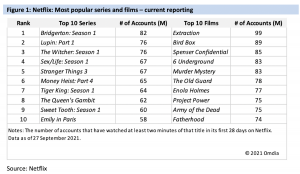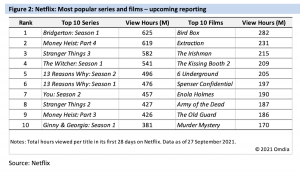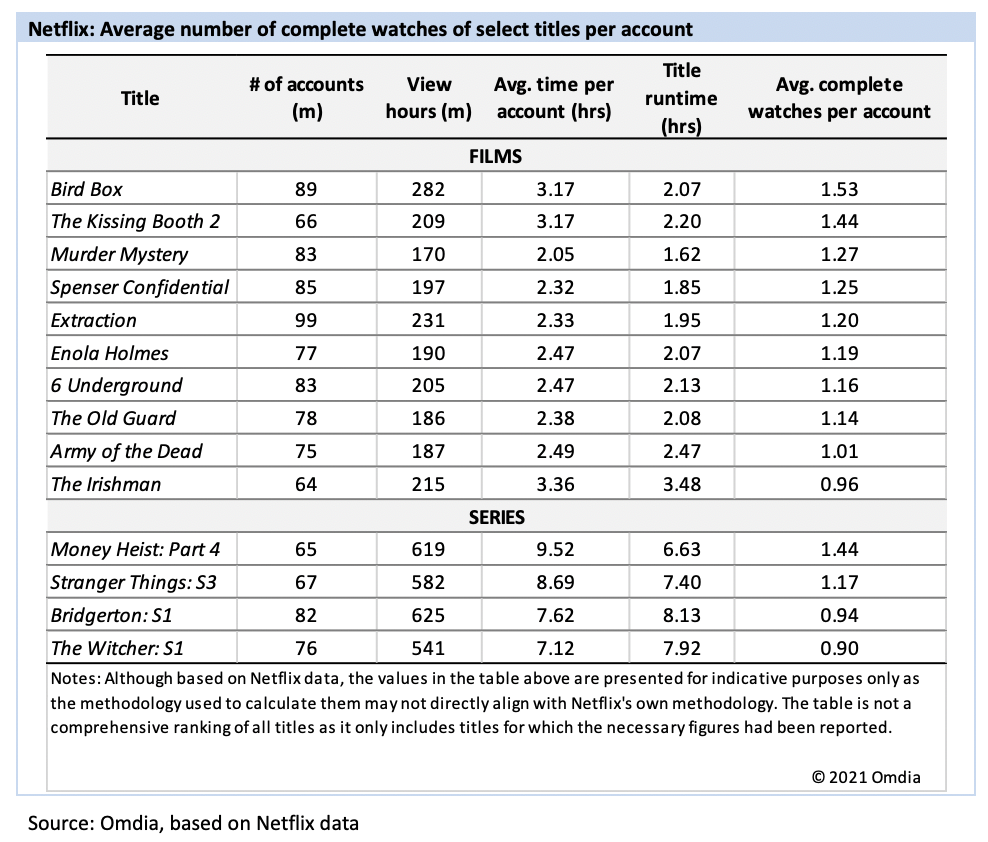
After more than 35 years of operation, TBI is closing its doors and our website will no longer be updated daily. Thank you for all of your support.
TBI Tech & Analysis: Why Netflix chose its new viewing metric

Squid Game
Netflix recently revealed a swathe of new data reflecting its most-watched shows using a new metric of total hours viewed. Omdia’s Matthew Evenson provides his take on why the streamer has made the move and reveals what we can learn.
In its 2021 Q3 reporting, Netflix revealed that Korean series Squid Game had been watched by 142 million member households in the first four weeks since its release.

[Click to expand]
This households metric counted any account that watched at least two minutes of a Netflix original film or series within the first 28 days of release.
It was used by the streamer since early 2020 to demonstrate the success of its key releases to its shareholders and the wider industry.
However, Netflix has replaced this metric with a 28-day total of hours viewed for a title, which it suggests is more in line with viewing measurements by outside services and will better account for rewatching of titles.

[Click to expand]
The streamer has published figures for both the top 10 original series and films as per its previous and new metrics.
There is some overlap in the two sets of tables and with figures that Netflix has published in recent years, which can be manipulated to gain additional insight into which of Netflix’s titles its subscribers have engaged with most.
Insights & takeaways
Dividing a title’s view hours by the number of accounts that viewed it gives the average time spent watching the title per account. Dividing this number by the total runtime of the title (as listed on Netflix’s platform) gives an average number of complete watches of a title per account.
Many titles have an average number of complete watches per account above one, but this doesn’t indicate that everybody watched the content more than once. This number can go above one because many Netflix accounts are used by multiple people (either as part of the same household or otherwise), who will have watched the title at different times. There will also be some people who will have opted to rewatch titles they particularly enjoyed or sections of them.

Of the films, Bird Box scores the highest number of average complete watches per account. The Kissing Booth 2 and The Irishman recorded similar figures under Netflix’s two metrics. However, The Irishman scored a lower average number of complete watches per account because of its near 3.5-hour runtime, compared to The Kissing Booth 2’s runtime of 2.2 hours (2 hours and 12 minutes).

La Casa Del Papel
Unsurprisingly, later seasons score higher than first seasons of series as viewers become more committed to watching all episodes of a series the further into it they progress.
Additionally, viewers are more likely to start watching the new seasons of returning shows closer to their release, whereas they may not start watching a new series until it is recommended to them, either by the Netflix platform or a friend or family member.
As a result, there is more likely to be viewing of new series happening outside of the 28-day period covered by Netflix’s metrics, than of viewing of returning series.
Metric transparency & comparisons
The significant rewatching of titles evident from the analysis supports Netflix’s decision to switch to the new metric and will ensure that it can report the full extent of its successes in the future.
While speaking at Code Conference in September 2021, Netflix’s co-CEO and chief content officer Ted Sarandos previewed the new view hours metric and said that the company was, “trying to be more transparent with the market and with talent and everybody.”
However, opting to discontinue the metric it has used for nearly two years means that it will be impossible to gauge the success of Netflix’s future titles compared to its older titles.

Bridgerton
Both metrics also, by design, exclude viewing of old third-party series and films, which account for a lot of viewing time spent on the platform. As such, it’s hard to argue that Netflix has become more transparent; instead, it is just slightly more transparent in a different way.
Netflix is, of course, under no obligation to self-report viewing data, so it’s unsurprising that it has chosen a method that enables it to highlight its biggest successes while retaining control of what to report.
Furthermore, Netflix’s reporting is far better than that of most of its streaming competitors, who often make statements championing the success of certain titles with no actual data to back up the claim.
In July 2021, Apple announced that the first episode of Ted Lasso’s second season drew the biggest audience of any Apple TV+ show but provided no actual numbers.
In March 2021, Disney announced that The Falcon And The Winter Soldier was the most watched Disney+ series premiere during its first weekend, joining WandaVision and season two of The Mandalorian in the top three.

Ted Lasso
Not only does HBO Max not report its own viewing figures, but it also doesn’t partake in Nielsen’s ranking of viewed minutes of original streaming titles, which is based only on viewing from US consumers’ TV sets and covers Netflix, Amazon Prime Video, Apple TV+, Disney+, and Hulu.
Despite early subscriber-acquisition success, services such as Disney+, HBO Max, and Paramount+ have yet to establish a truly global presence on the same scale as Netflix has done. As such, it’s of little benefit to many of these new services to publish total viewing data that would only lead to unfavorable comparisons with Netflix.
Figures such as Bridgerton’s 625 million view hours are almost too large to truly comprehend: 625 million hours is equivalent to just shy of 71,300 years. However, such numbers also require little to no context to understand: 625 million view hours is a lot, and that’s all that Netflix wants you to understand.
Matthew Evenson is media analyst for research and entertainment at Omdia, which – like TBI – is part of Informa. For more information, click here.


